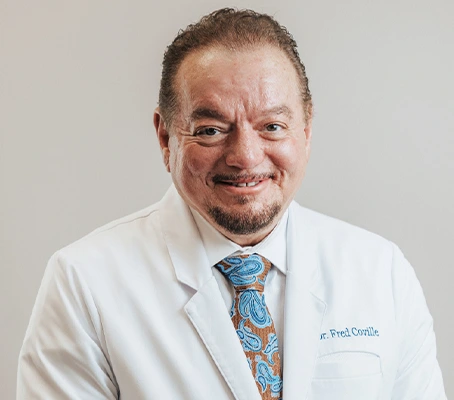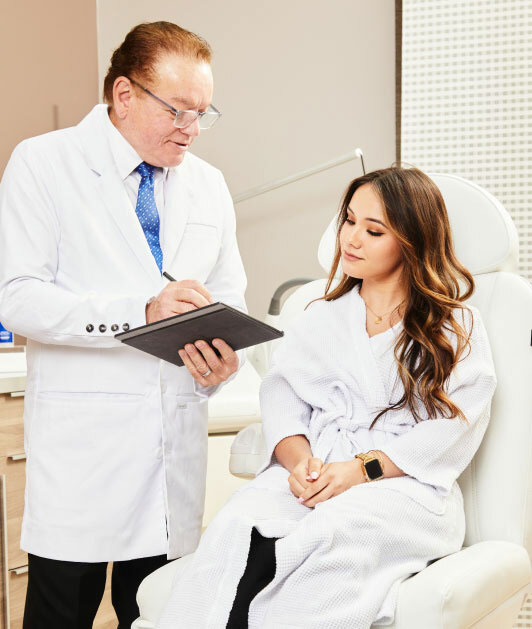- Select Language ▼
Cornerstone Plastic Surgery has partnered with Rejuvenessence to bring you an expert-led Weight Loss Program. Learn More on our partner’s website!
Scars—whether from accident or surgery—are unpredictable in the way they form. Their appearance during and after healing depends as much on your body as on the original injury or the surgeon’s skill. Variables affecting the degree of scarring include wound size and depth, the area’s blood supply, skin thickness and color, and the scar’s direction. Again, how much the appearance of a particular scar bothers you is a personal matter.
Not all scars can be removed entirely, but a skilled plastic surgeon can often improve their appearance by injecting or applying certain medications or through surgical procedures known as scar revisions. Dr. Fred Coville has extensive experience with scarring of all types and frequently uses combination therapy to improve his results. Combination therapy can include topical creams and medications, microdermabrasion, chemical peels—most notably Dr. Fred’s Controlled Depth Peel—surgical subcision, dermabrasion, microneedling, radiofrequency treatments, laser treatments, or surgical revision. What can and should be done in your case will depend on a consultation with Dr. Coville. However, the following introductory paragraphs will, we hope, give you a basic understanding of the most common types of scars, the procedures available to treat them, and the results you can expect.
Keloid Scars
The key difference between keloid scars and other scars is that these thick, puckered, itchy clusters of scar tissue will grow beyond the edges of wounds and incisions. In other words, the scar formation takes up more area than the original wound that caused it. Often, keloid scars are red or of a darker hue than the surrounding skin. Keloids appear when the body continues to produce the tough, fibrous protein known as collagen after a wound has healed. Keloids can appear anywhere on the body but are most common over the breastbone, earlobes, and shoulders. They occur more in dark-skinned people than in fair ones, but they can and do occur in persons of any ethnic background or descent. The tendency to develop keloids can run in families. But the good news is this tendency lessens with age.
The initial treatment is often injecting a steroid medication directly into the scar tissue to reduce redness, itching, and burning. Sometimes this also shrinks the scar. If steroid treatment is inadequate, the scar tissue can be cut out and the wound closed with one or more layers of stitches. This is generally an outpatient procedure performed under a local anesthetic. You should be back at work in a day or two, and the stitches can be removed after a few days. A skin graft is occasionally used, although the site from which the graft is taken may itself develop a keloid.
Unfortunately, keloids have a stubborn tendency to recur no matter what techniques are used, and sometimes they may be even larger than before. Combining scar removal with steroid injections, direct application of steroids during surgery, and radiation therapy may help. Another treatment is wearing a pressure garment with or without silicone sheeting for as long as a year. Dr. Coville frequently uses a combined approach to treating these stubborn scars, including topical medications and chemical peels to improve the results. Even so, the keloid may return, requiring repeat procedures every few years. During your consultation with Dr. Coville, he will be happy to go over all the treatment options and explain his expected results based on his extensive experience in this area.
Hypertrophic Scars
Like keloids, hypertrophic scars can be thick, red, and raised but are different because they remain within the original incision or wound boundaries. They often improve on their own, taking a year or more to heal fully. Steroid applications, topical creams, microdermabrasion, chemical peels, or injections can help. Dr. Coville often uses several therapies concurrently to get the most improvement.
Alternatively, or in combination with other modalities, hypertrophic scars may often be improved surgically. Dr. Coville removes excess scar tissue and may reposition the incision to heal in a less noticeable pattern. This surgery may be done under a local or a general anesthetic. Non-surgical manipulations to control wound healing, such as steroid injections during surgery and at intervals for up to two years afterward, can help prevent the scar from reforming.
Contractures
Burns or other injuries where a large area of skin is lost may form a scar that pulls the edges of the skin together. The resulting ‘contracture’ may affect adjacent muscles and tendons and restrict normal movement. Surgical correction usually involves cutting out the scar and replacing it with a skin graft or a flap. In some cases, a procedure known as Z-plasty may be used. Other advanced techniques, such as tissue expansion, are also playing an increasingly important role. After surgery, physiotherapy may be necessary to restore full muscle function.
Facial Scars
Some facial scars may be made less noticeable by cutting them out and closing the wound with tinier stitches to leave a thinner, less noticeable scar. Others can be softened using dermabrasion, lasers, or chemical peels to achieve a controlled removal of the top layers of the skin. These techniques leave a smoother skin surface but will not completely erase the scar. Dr. Coville will often use subcision, prescription topical creams available through our skincare line, laser and light-based treatments, and radiofrequency and chemical peels to improve both the scarring and the hyperpigmentation associated with scars.
Scars that appear large and unattractive immediately after surgery naturally become less noticeable with time. Some initial tenderness and itching can also be relieved by treatment with steroids, other medications, or even some superficial chemical peels. For these reasons, many plastic surgeons recommend waiting as long as a year or more after the injury or surgery before you decide to have a scar revision. Your first step, if scarring is bothering you, is to consult with Dr. Coville. He will examine you and discuss the available treatments, the risks and benefits involved, and the possible outcomes. Be frank about your expectations to make sure they are realistic, and bring up all your questions and concerns.

Z-Plasty
This surgical technique repositions a scar to follow a natural line or crease in the skin more closely, becoming less noticeable. It can also reduce the tension caused by contracture. Z-plasty is not recommended for all scars, however. Essentially the old scar is removed, and new incisions are made on each side, creating small, triangular flaps of skin. These flaps are then rearranged to cover the wound at different angles, giving the scar a Z-pattern. Fine stitches are used to close the wound and are removed a few days later. Usually performed as an outpatient procedure under a local anesthetic, Z-plasty can make some scars less noticeable but cannot make them disappear. A portion of the scar will still remain outside the lines of relaxation.
Dermabrasion
Dermabrasion has been around for decades, originally using sandpaper to remove damaged skin. Now a machine rotates a small diamond burr, which removes the damaged skin. Of course, the skin is numbed or frozen first. After the procedure, your skin is raw, and scabs will form—much like the scrapes you got on your knees during childhood. After the scabs heal, your skin can be reddish for several weeks, but that will improve with time. You will see a dramatic improvement in the texture and thickness of any scars treated by this method.
Augmentation
Augmentation is a procedure where a filler material like JUVÉDERM®, Restylane®, RADIESSE®, or your own fat will be injected under the scar to bring it to the surface. Depending on the location, these treatments may last 6 months or more. Dr. Coville frequently combines this with subcision first.
Subcision
Subcision detaches the scar from deeper tissue and creates an empty space under the scar. The techniques used by Dr. Coville quickly release deep lines and scars by separating connections to underlying deeper tissues. Subcision with the SurgiWire Dissector creates empty space, which can be filled with fillers such as JUVÉDERM®, Restylane®, or RADIESSE®, or your own fat. If you and Dr. Coville choose not to use fillers, he may leave the small space to form connective tissue under the scar, thereby leveling it with the rest of the skin’s surface. Subcision is usually combined with a chemical peel. The depth and shape of your scars, along with other factors such as skin color, will help Dr. Coville determine what treatment is best for you during your consultation in Toms River or Linwood, NJ.
Skin Grafting And Flaps
Skin grafts and flaps are more major forms of scar surgery and may be carried out using a general anesthetic. Treated areas may take several weeks or months to heal, and a support garment or bandage may be necessary for up to a year. Skin grafting involves transferring skin from a healthy part of the body to cover the injured area. The graft is said to ‘take’ when new blood vessels and scar tissue form in the injured area. Sometimes grafts do not take, and all grafts leave some scarring at both the donor and recipient sites. Flap surgery is a complex procedure in which skin, the underlying fat, blood vessels, and sometimes muscle are moved from a healthy part of the body to the injured part. In some flaps, the blood supply remains attached at one end to the donor site. In others, the blood vessels in the flap are reattached to vessels at the new site using microvascular surgery. Both techniques can significantly improve function. However, the cosmetic results may be less satisfactory because of the difficulty of matching skin color and texture. Flap surgery generally produces better cosmetic results than skin grafts.
Insurance usually does not cover cosmetic procedures. However, your insurance carrier may cover the procedure in whole or in part if your scar revision is intended to minimize scarring from an injury, decrease pain, or improve your ability to function. Please check with your insurer. We can help you with that when you visit us at Cornerstone Plastic Surgery & Aesthetic Medicine in Atlantic County, New Jersey.
Carefully follow Dr. Coville’s recovery instructions to make sure the wound heals properly. You may be out of bed very quickly, but resuming your normal activities should be gradual.
Keep in mind that scars cannot be removed completely, and the degree of improvement depends on the size and direction of your scar, the nature and quality of your skin, and how well you care for the wound after the operation. Your scar may look worse at first, but do not panic. Chances are you will be pleased with the final results, which may not become apparent for a year or more.
Scar revision usually is safe, but complications can occur as with any surgical procedure. They include infection, bleeding, a reaction to the anesthesia, or further unsightly scarring. Reduce your risks by choosing an experienced and well-qualified surgeon such as Dr. Fred Coville and following his advice closely before and after surgery.
Written By: Dr. Frederick Coville
Frederick A. Coville, M.D., Cornerstone Plastic Surgery’s Owner and Medical Director
Frederick A. Coville, M.D., Cornerstone Plastic Surgery’s Owner and Medical Director, has been an Aesthetic and Reconstructive Plastic Surgeon for over 25 years. He firmly believes each of us possesses an inner “Foundational Beauty.”
As a student of beauty all his life, he calls upon his naturally artistic eye and God-given talents as a surgeon to deliver the results you demand. Dr. Fred likes to say, “It’s my job to help you find Your Beautiful!”
Request your consultation and let
us create a custom experience for you
